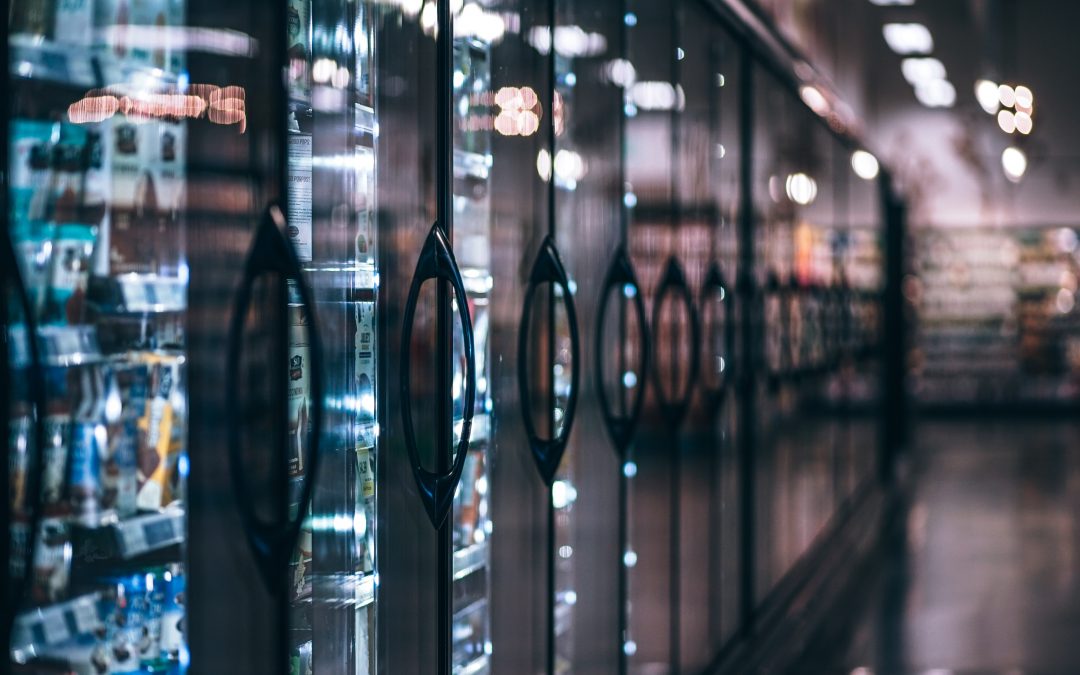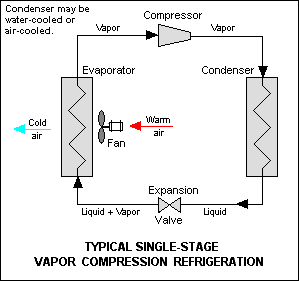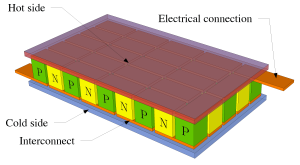Artificial cooling is not a particularly new technology. The practice of using ice-storehouses and iceboxes to preserve food dates back to the early 19th century. Harvesting ice in areas like New England for shipment to places like the American south and the Caribbean islands was big business for much of the 19th century. However, the technology used to keep things cool has changed greatly over the last hundred years. The main advancement was the development of vapor-compression cycle refrigeration systems in the early 1900’s. This advancement in refrigeration and cooling had a huge impact on life in the 20th century and beyond. Refrigeration changed the way we eat, where we live, and the way our cities are built.
Vapor-compression refrigeration has dominated the industry since the early 20th century. At its core, the process is extremely simple: circulate a cold fluid around the object to be cooled, allowing that fluid to absorb heat from the object and carry it away. Using this principle, you can create a closed system that continuously creates cooled fluid to generate constant refrigeration. This is the crux of the vapor-compression cycle. The system uses a compressor to pressurize a vaporized refrigerant (which nowadays is usually R-134a in the U.S., which replaced Freon in the 1990s after Freon was found to be degrading the ozone layer). The refrigerant is pumped through a condenser, were it is converted from a high pressure, high temperature vapor into a high pressure liquid. Heat is generated from the phase change, which the condenser dissipates. The high pressure liquid is then run through an expansion valve to create a pressure drop, which greatly reduces the temperature of the refrigerant. The last step in the process is to send the cold refrigerant through the evaporator coils, where the refrigerant returns to vapor form while absorbing heat from the surrounding areas, cooling them.
While R-134a is much safer and has lower ozone depletion potential than previous refrigerants (e.g. ammonia and Freon), the environmental impact is not zero. Therefore, methods of cooling without relying on a vapor compression cycle are very desirable, and research into these methods represent a growing technological field. An article in the December edition of Physics today discusses the emerging technologies in “solid-state cooling.” These technologies take advantage of the repeated “ordering” and “disordering” of the subject materials to produce a reaction similar to the compression and expansion of traditional volatile liquid refrigerants like R-134a.
The article discusses three major methods for inducing this reaction. One method, called magnetocaloric cooling, involves applying magnetic fields to certain materials like Gadolinium. The fields cause the dipoles of the material’s atoms to align, which reduces the material’s heat capacity, leading to the release of heat as it cools. When the field is shut off, the atoms alignment is no longer constrained, and heat is adsorbed from the surrounding area as the heat capacity increases again. Repeating the process creates a refrigeration cycle similar to that of vapor compression system. Another technique, called electrocaloric cooling, applies electric fields (instead of magnetic fields) to achieve the same effect. The last technique discussed is called elastocaloric cooling. This involves stretching a specific material (such as certain Nickel-Titanium alloys) to create a release of latent heat as the material’s structure changes. When the stress is released, heat is absorbed from the surrounding area as the material returns to its rest state. All of these methods discussed in the article are alternative ways to cool a space that don’t involve traditional refrigerants, but they are by no means the only alternatives.
Yet another way to cool an area without the use of a refrigerant is with a thermoelectric cooler (also called a Peltier cooler). Thermoelectric coolers work by running a direct electric current between two parallel semiconducting plates. As the current travels between the plates, it carries heat from one side to the other. If the “cold” side is connected to an area to be cooled (say, the inside of a refrigerator), and the “hot” side is connected to a heat sink, then this system can produce results similar to a traditional vapor compression system.
There are several advantages to using a thermoelectric cooler over a traditional vapor compression system. First, the thermoelectric cooler has no moving parts, so maintenance is easier. They have long lifetimes so they need to be replaced less often. Also, there is no possibility of breakdowns associated with leaking refrigerant since the entire system is liquid-free. Further, it can provide very tight temperature control.
While thermoelectric coolers are generally not capable of generating large changes in temperature from the ambient, at least not efficiently, not all refrigeration applications require huge amounts of cooling. Take drosophila experiments, for example. Drosophila experiments are often carried out near 25°C, which is very close to the ambient temperature in most situations. Using a thermoelectric cooler for those types of applications represents an upgrade to both the maintenance requirements and reliability of drosophila incubators. That’s why, starting in 2016, our level 2 and level 3 Drosophila & Small Insect Chambers will be equipped with thermoelectric coolers standard. Of course, a traditional compressor can be installed if required, since all our chambers are custom built to the specifications required for each customer’s application.
For more information about our Drosophila Chambers, visit our Contact Us page or call us at (800) 998-0500.



